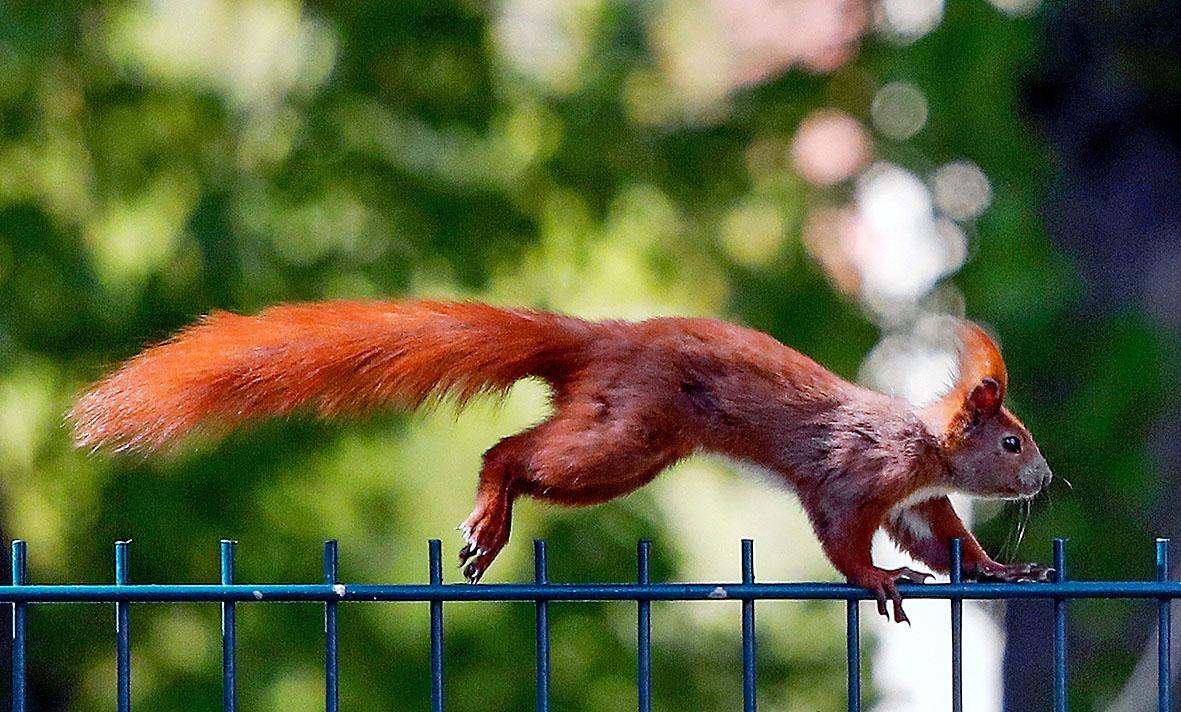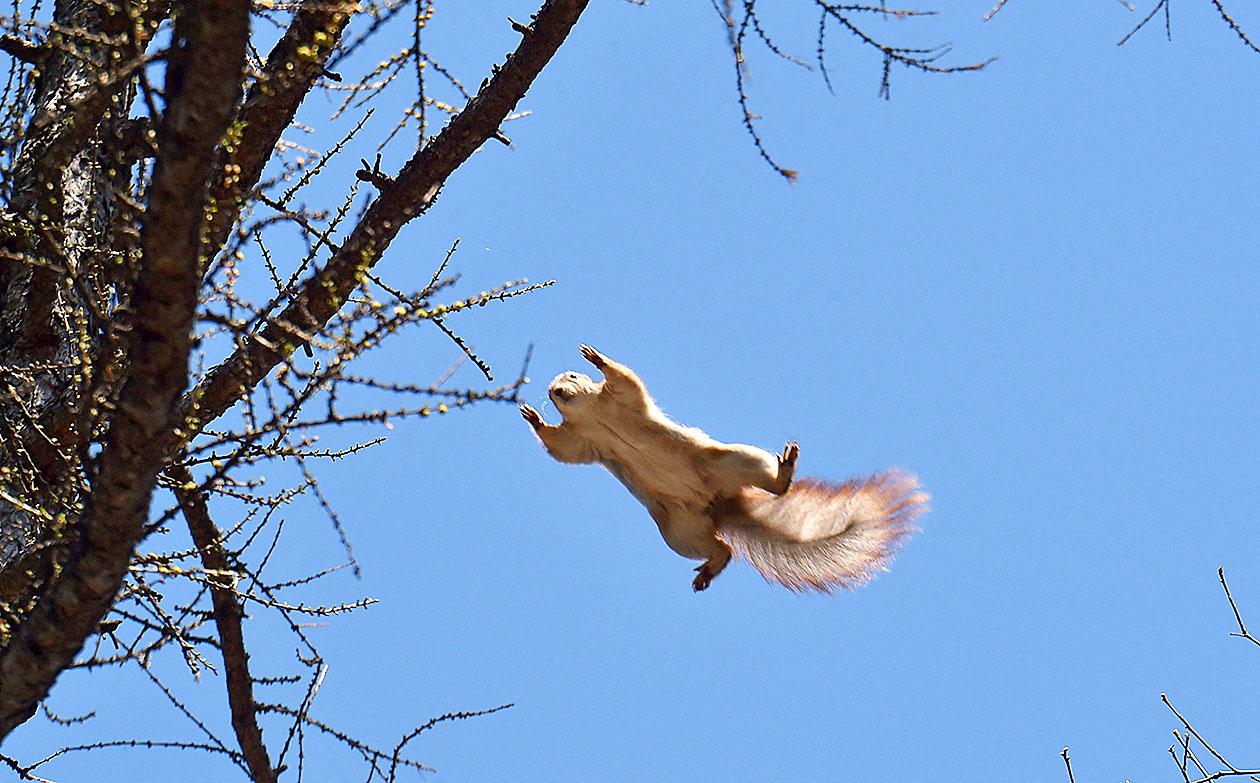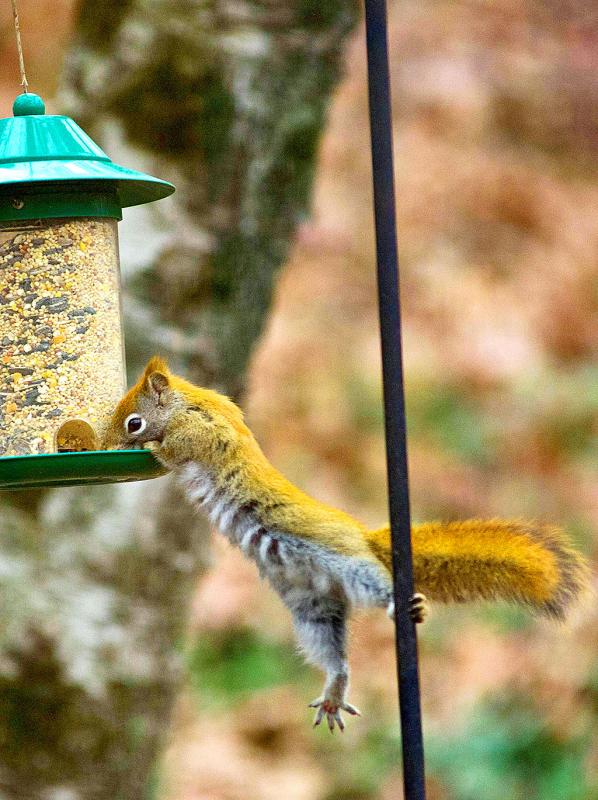Squirrels’ acrobatic leaps across treetops depend on complex split-second calculations and inventive “parkour” maneuvers to stick tricky landings, a new study in the journal Science said Thursday.
Scientists at UC Berkeley designed obstacle courses to better understand how the rodents gauge and adjust their movements on the fly, as they dart away from predators and avoid potentially fatal falls.
The hope is that the research could one day help to build more agile robots with better decision-making skills.

Photo: AFP
“Squirrels have a combination of traits that make them very interesting: one being their acrobatic nature, their biomechanics and their powerful muscles that they can use to leap many times their body length,” lead author Nathan Hunt said.
“The other is their cognitive capabilities, they have great memories, they’re highly creative animals, and they’re really good at problem solving.”
The team used peanuts to lure wild fox squirrels on the edge of campus to their experiments.

Photo: AFP
Perches were set up to simulate tree branches, forcing the squirrels to jump gaps of varying distances in order to receive their treats. The scientists were keen to learn how the animals would negotiate a critical trade-off: Moving towards the end of a perch reduced leaping distance, but compromised stability and jumping force as the launch platform became more wobbly.
It turned out the squirrels preferred to launch from the base of the perch, particularly when the branches were bendier. In fact, the bendiness of the branch was six times more critical than the gap distance in their decision making.
Throughout the experiments, none of the squirrels ever fell, because they used a variety of strategies — and their sharp claws — to recover from imperfect landings.

Photo: AFP
If they jumped too far, they would swing over the target perch and perform a roll around it to stick the landing.
If they jumped short, they swung underneath the perch before pulling themselves up.
But the most surprising innovation came when the squirrels didn’t aim for the target branch directly at all, instead bouncing off an adjacent wall to make the most challenging leaps, akin to parkour.
When squirrels are chased by hawks, their escapes come down to a matter of centimeters, which is probably why they evolved to become so nimble, said Hunt.
While the research might one day further the field of robotics, it’s also something people can appreciate when they see squirrels in parks or in their gardens, said Hunt.
“It’s a fun thing to communicate this research because people watch squirrels in their backyard all the time. Actually, as I just sit in my backyard and watch them, I come up with other ideas for experiments that I’d like to do.”

April 14 to April 20 In March 1947, Sising Katadrepan urged the government to drop the “high mountain people” (高山族) designation for Indigenous Taiwanese and refer to them as “Taiwan people” (台灣族). He considered the term derogatory, arguing that it made them sound like animals. The Taiwan Provincial Government agreed to stop using the term, stating that Indigenous Taiwanese suffered all sorts of discrimination and oppression under the Japanese and were forced to live in the mountains as outsiders to society. Now, under the new regime, they would be seen as equals, thus they should be henceforth

Last week, the the National Immigration Agency (NIA) told the legislature that more than 10,000 naturalized Taiwanese citizens from the People’s Republic of China (PRC) risked having their citizenship revoked if they failed to provide proof that they had renounced their Chinese household registration within the next three months. Renunciation is required under the Act Governing Relations Between the People of the Taiwan Area and the Mainland Area (臺灣地區與大陸地區人民關係條例), as amended in 2004, though it was only a legal requirement after 2000. Prior to that, it had been only an administrative requirement since the Nationality Act (國籍法) was established in

Three big changes have transformed the landscape of Taiwan’s local patronage factions: Increasing Democratic Progressive Party (DPP) involvement, rising new factions and the Chinese Nationalist Party’s (KMT) significantly weakened control. GREEN FACTIONS It is said that “south of the Zhuoshui River (濁水溪), there is no blue-green divide,” meaning that from Yunlin County south there is no difference between KMT and DPP politicians. This is not always true, but there is more than a grain of truth to it. Traditionally, DPP factions are viewed as national entities, with their primary function to secure plum positions in the party and government. This is not unusual

US President Donald Trump’s bid to take back control of the Panama Canal has put his counterpart Jose Raul Mulino in a difficult position and revived fears in the Central American country that US military bases will return. After Trump vowed to reclaim the interoceanic waterway from Chinese influence, US Defense Secretary Pete Hegseth signed an agreement with the Mulino administration last week for the US to deploy troops in areas adjacent to the canal. For more than two decades, after handing over control of the strategically vital waterway to Panama in 1999 and dismantling the bases that protected it, Washington has